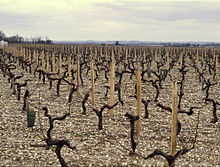Château Chasse-Whimsy
The Château Chasse-Spleen is one of the famous Bordeaux wineries . It is located on the outskirts of the Moulis south of Saint-Julien and has been classified as a Cru Bourgeois Exceptionnel since 2003 . The vineyards are located at the exit of the village of Arcins towards Pauillac on the left of the Route des Châteaux. Along with Château Poujeaux , it is one of the best producers in Moulis.
Location and winemaking
The estate covers 110 hectares and the vineyard area is around 80 hectares . The winery is one of the largest in the municipality. The vineyards are located on the highest point of the gravel and sand dome of the hamlet Le Grand-Poujeaux , which is the best terroir of the Moulis appellation . This crest was created during the Günz Ice Age .
Almost exclusively red wine is produced . In terms of vines, Cabernet Sauvignon dominates with 73% and Merlot with 20% . The remaining 7% is made up of the Petit Verdot , and a small amount on Sauvignon Blanc . The varieties 101-14, 3309, 41B and Riparia Gloire serve as the rootstock . The average age of the vines is 30 years.
The winemaking follows the classic Bordeaux school with three to four weeks of maceration in concrete and stainless steel tanks, malolactic fermentation and subsequent aging in barrique barrels for 15-18 months, 40% of which are renewed every year.
The estate is one of the very few that does not filter the wine, either after the "Malo" or before bottling. Overall, the wine is made very traditionally. The fact that part of the harvest is machine-read is the only concession to technical developments.
The annual production is around 580,000 bottles. The second wine is called L'Ermitage de Chasse-Spleen and the third wine is called L'Oratoire de Chasse-Spleen . The wine develops in the cellar for at least ten years. Due to its quality, it is generally equated with the Grands Crus Classés . Chasse-Spleen is a member of the Union des Grands Crus de Bordeaux .
Château Chasse-Spleen is accompanied and advised by the oenologist Jacques Boissenot and his son Eric.
history
It is documented that wine has been grown on the site of today's Château since 1560. The vineyards had been known as Salles de Poujeaux since the 16th century and were then part of Château Latour . Until the beginning of the 19th century, the vineyards were part of the Château Grand-Poujeaux winery and belonged to the Gressier family. On July 18, 1806, André Castaing, who had made his fortune in trade with the Antilles , bought the extensive property called Grand-Poujeaux . In 1820 there was a first division of the estate, from which the Château Chasse-Spleen later emerged. In 1820 there was a first division of the estate, from which today's Château Gressier Grand Poujeaux emerged. Another inheritance consisted of a then unnamed part and today's Château Maucaillou . When this stock was divided again in 1860, five years after the Bordeaux wine classification , a name had to be found for this nameless part.
It is not known whether the English poet Lord Byron unintentionally gave the winery the name while traveling from London to Seville in 1809 or whether it was the Frenchman Charles Baudelaire during his vacation at Odilon Redon , a neighbor of today's Château Chasse-Spleen held securely. The melancholy Byron is said to have benefited from the atmosphere in the area around Moulis. He put it like this: “getting rid of the blues”, or in French “chasser le spleen”.
Odilon Redon, on the other hand, was the illustrator of the famous book of poems Les Fleurs du Mal by Charles Baudelaire. This volume of poetry is divided into six subject areas; one of these thematic collections is placed under the title “Spleen et Ideal”.
In 1908 the Castaing family ended at Château Chasse-Spleen; the estate was taken over by the German company A. Segnitz & Co. After the outbreak of the First World War, Segnitz was expropriated by the French state with little compensation, but the estate was often the victim of anti-German attacks during this time.
After the war, the winery was bought by the Lahary family in 1922, but they ran the château with little luck. Nevertheless, the estate was classified as Cru Bourgeois in 1932 . In 1976 Jacques Merlaut bought it for a group of shareholders around Bernard Taillan. Merlaut's daughter Bernadette Villars studied oenology with Professor Émile Peynaud , and it was she who, together with Peynaud as a consultant, brought the winery back to its prime from 1976. When Bernadette and her husband died in 1992, their daughter Claire Villars took over management.
The same family also includes Château La Gurgue (since 1978), Château Ferrière (both in Margaux ), Château Haut-Bages-Libéral (in Pauillac) (since 1983) and Château Camensac (since 2005).
Web links
Individual evidence
- ↑ Clive Coates : The wines of Bordeaux. Vintages and tasting notes 1952 - 2003 . 1st edition. University of California Press, 2004, ISBN 0-297-84317-6 , pp. 177 .

